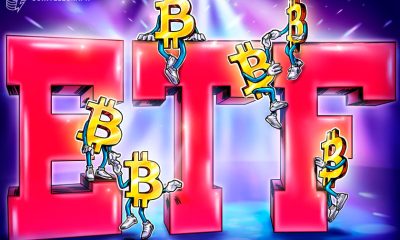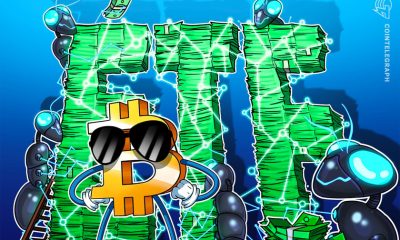Bitcoin
Happy birthday dear Bitcoin: Crypto’s first white paper turns 12

An assessment of Satoshi Nakamoto’s Oct. 31, 2008 paper that “set in motion a revolution in finance.”
Has it only been a dozen years since Oct. 31, 2008, that Satoshi Nakamoto published a modest nine-page paper describing a new online payments system called “Bitcoin?” Depending on where one stands, that pseudonymous white paper — its author(s) remain unidentified — fostered either a fintech revolution or, as some believe, “the greatest scam in history.”
To mark the anniversary of the publication of “Bitcoin: A Peer-to-Peer Electronic Cash System,” Cointelegraph invited comments on the enduring vision of the paper’s author. Would Satoshi Nakamoto have been pleased with how Bitcoin and blockchain technology have developed and evolved over the past 12 years?
James Angel, an associate professor at Georgetown University’s McDonough School of Business, told Cointelegraph: “It has set in motion a revolution in finance with the rise of DeFi apps, smart contracts, and coin offerings, in addition to a payment revolution that is leading to central bank digital currencies.” Gina Pieters, an assistant instructional professor at the University of Chicago’s economics department, told Cointelegraph: “He would be pleased to see the evolution and new applications of his vision.”
The influence of Bitcoin’s (BTC) white paper goes beyond finance, Garrick Hileman, head of research at Blockchain.com, told Cointelegraph: “Its impact is worthy of being considered alongside other major technical innovations, such as the personal computer and internet.”
Would Satoshi be disappointed?
Satoshi’s vision was for a P2P, or decentralized, digital cash system — as referenced in the white paper’s title. The problem with incumbent digital commerce was that it relied exclusively on “financial institutions serving as trustedthird parties to process electronic payments,” Satoshi wrote. This had inherent weaknesses. Transactions could be reversed, banks had to mediate disputes, and transaction costs were high. Satoshi’s solution was presented in the second paragraph of the white paper’s introduction:
“What is needed is an electronic payment system based on cryptographic proof instead of trust, allowing any two willing parties to transact directly with each other without the need for a trusted third party.”
In the 12 years since the paper’s publication, the need for P2P transactions — without interfering third parties — has become something of an article of faith among Bitcoinists. But, on reflection, has this aspect of Satoshi’s vision been fulfilled? David Yermack, a professor of finance at New York University’s Leonard N. Stern School of Business, told Cointelegraph:
“I think the greatest source of disappointment for Nakamoto would be the increasing centralization of blockchain governance in entities such as mining pools and even central banks, which are on the verge of launching their own cryptocurrencies. Nakamoto’s mission was to challenge the hegemony of central banks, and ironically, the greatest issuers of digital currencies seem likely to be the central banks themselves.”
Angel went further: “Satoshi would be appalled at the politics of concentrated mining pools that currently dominate the Bitcoin protocol.” While Pieters added that Satoshi would be disappointed that the “primary transactions of Bitcoin were not occurring through peer-to-peer trading, but rather intermediated by centralized exchanges or companies.”
Thwarting fraud
The matter of fraud in digital transactions has always loomed, and in Bitcoin’s white paper Satoshi proposed a way to solve the classic “double-spend” problem — where miscreants spend the same coin twice, something not difficult to do with electronic coins. He did this using a “peer-to-peer distributed timestamp server to generate computational proof of the chronological order of transactions.” In this way, explained Satoshi, “transactions that are computationally impractical to reverse would protect sellers from fraud.”
Solving the double-spend problem today is considered one of Satoshi’s greatest achievements. His Bitcoin blockchain has never been hacked (though the same can’t be said for the many crypto exchanges that trade BTC). Still, fraud associated with digital payments has not been squeezed out of the system. Would this have dismayed Bitcoin’s founder?
Angel said that Satoshi would “have been disappointed that Bitcoin did not turn into an everyday payment medium but instead a store of value for fearful fatcats and tax evaders.” Moreover, Satoshi would “have been saddened by the increase in inequality that Bitcoin’s history has created, with a few early adopters becoming whales and the other 99.99999% of the population as have nots.” Still, one assumes Bitcoin’s creator — whether man, woman or group — would have marveled at the breadth of BTC’s adoption, as Yermack outlined:
“Nakamoto would be astonished by the growth of blockchain projects and the many thousands of digital coins and tokens that have been created in the image of Bitcoin. One suggestive piece of evidence is that Nakamoto fixed the size of the blocks on the Bitcoin blockchain at 1MB in 2010 and mysteriously commented that ‘we can always increase this later when we need to.’”
He had no inkling that the blockchain would become overloaded within the next five or six years, continued Yermack, “and that a contentious debate, still unresolved today, would break out among different constituencies of Bitcoin about the best way to expand the blockchain’s capacity further.”
In the past 12 years, most of Satoshi’s original software code has been altered or substituted, added Hileman, but still, Bitcoin has retained its key foundational qualities, including “its fixed supply of 21 million coins, open access, and censorship/tamper resistance. I believe Satoshi would be happy with the ongoing software optimizations and improvements to these core foundational characteristics that continue today.”
Was Satoshi an environmentalist?
While the white paper says a lot about transaction fees, CPU power, network nodes, proof-of-work chains, and even the Gambler’s Ruin problem, it says nothing much about the larger world around, including the environment. Angel contends that Satoshi would be shocked by the environmental damage caused by the Bitcoin mining arms race, adding: “At current hash rates and mining efficiency, Bitcoin mining alone is consuming about seven gigawatts of electricity, which is the equivalent to seven Chernobyl power plants.”
And while little is known about Satoshi’s politics, his creation, in the form of the first crypto blockchain, would also be disturbed by the idea of central bank digital currencies, and in some cases, “those currencies are designed for repressive governments to engage in even more surveillance and control over their populations,” added Angel.
Focusing on the white paper proper, Franklin Noll, a monetary historian and the president of Noll Historical Consulting, told Cointelegraph: “His concern was with speedy, anonymous, low cost, non-mediated, non-reversible transactions. So far, Bitcoin transactions — and many other blockchain transactions — have not been found to be all that speedy, anonymous, or low cost.” He further added:
“I believe Satoshi would want to see more use of non-custodial wallets to store and transact Bitcoin,” added Hileman, who explained that custody firms that manage private cryptographic keys on behalf of Bitcoin owners “resemble traditional banks.” Meanwhile, he believes that “Satoshi was not a fan of trusted third-party financial intermediaries.”
What is Satoshi’s legacy?
After a little more than a decade later, what is the significance of Satoshi Nakamoto’s white paper? In the financial sphere, “It incentivized financial companies and central banks to prioritize evaluating their technology, considering both increased digitization and ‘always-on’ digital platforms,” Pieters opined, continuing: “In some cases, like the renewed examinations of CBDCs, this has led to explorations of new systems even if it is not directly the adoption of blockchain technology.”
“Bitcoin and blockchain have fundamentally changed the monetary world,” added Noll. “Terms like proof-of-work, distributed ledger technology, decentralized finance, programmable money and smart contracts are now part of the lexicon of anyone serious about the future of money and finance.” Hileman added:
“We are also only beginning to understand the potential impact of blockchain technology in areas outside of finance, such as digital identity, addressing the problem of fake news, and public election tampering.”
“The publication of Nakamoto’s 2008 paper was an important turning point in financial record-keeping,” said NYU’s Yermack. “We are only beginning to understand the ramifications, but they appear to be vast.”
A surprisingly modest document
One won’t find the word “revolution” in Satoshi’s paper. There is nothing about overturning the economic order or narrowing the gap between rich or poor. It’s an unassuming treatise on electronic payments — how they can be made to function effectively.
On his own terms, Satoshi succeeded wildly. He promised a workable P2P digital payment system, and he delivered. The market value of Bitcoin stands at $251 billion 12 years after the idea was unveiled.
Whether Bitcoin is also harming the environment, abetting money launderers or propping up political regimes, goes beyond the scope of his paper. What can be said is that economic decentralization continues to present governance challenges. How much “peer-to-peer” does society really want? The larger global community will have to decide.
Twelve years out from the publication of “Bitcoin: A Peer-to-Peer Electronic Cash System,” it’s worth remembering that “it is a dictum of history that revolutions do not always turn out as the founders planned,” Noll told Cointelegraph.

















